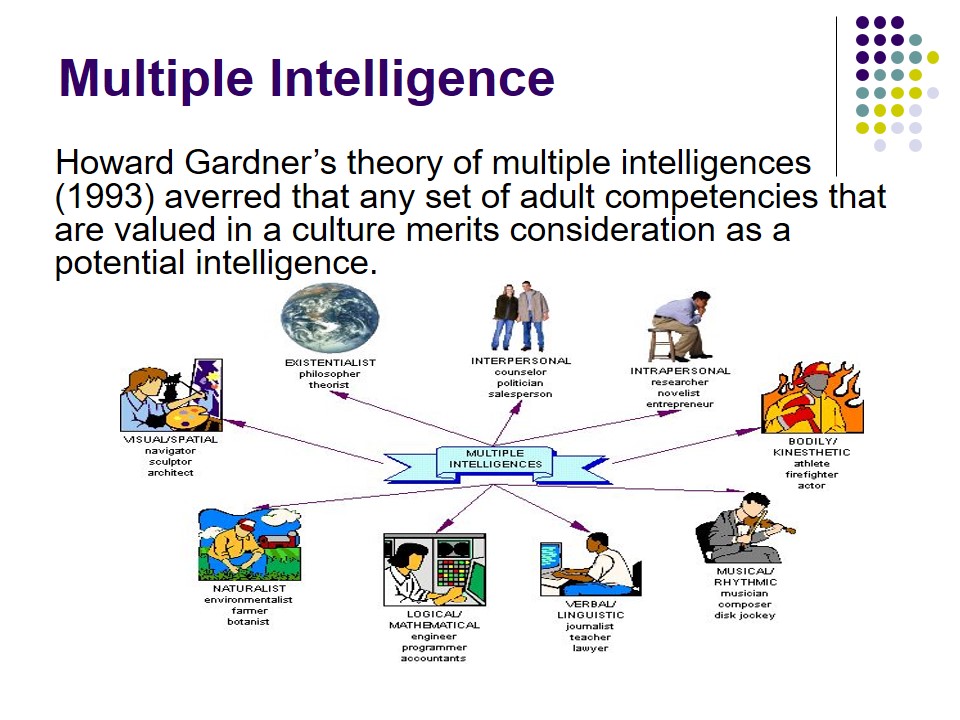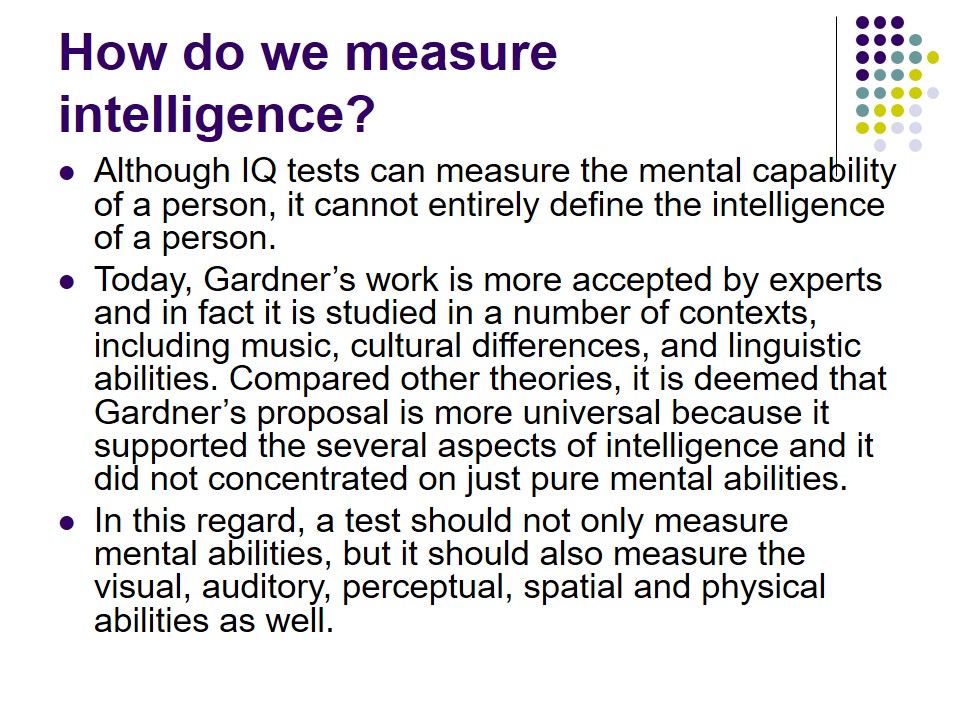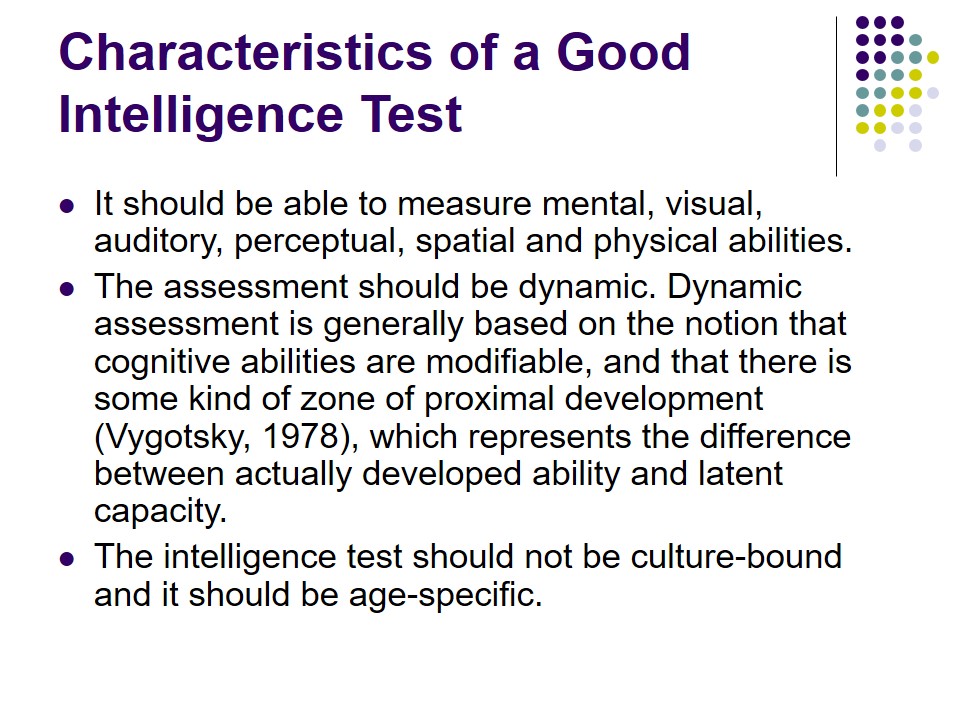What is Intelligence?
In psychology, it is essentially termed as “cognitive ability”. It is measured through IQ (Intelligence Quotient).
Testing one’s IQ can be a good indication of how general intelligence can be an ability. This general intelligence must be distinguished from other abilities such as verbal ability, numerical ability and perceptual speed.
However, psychometric theories of intelligence are based on the premise that intelligence can be described in terms of mental factors (Bjorklund, 2000), which are general mental skills that influence mental performance in a variety of situations.
Most of our knowledge of intelligence has come about through the development and use of intelligence tests. In fact, intelligence is sometimes defined as that which intelligence tests measure. This is not as circular as it might appear: what intelligence tests measure is known from studies of those who score highly and those who do not, and from studies of what can be predicted from intelligence test scores. Indeed the very notion of intelligence as a general ability comes about from investigations of intelligence tests and other scores. Well-known tests of intelligence are the Wechsler scales (for adults and children), the Stanford–Binet test and the British Intelligence Scale.

Redefining Intelligence
In this regard, intelligence is the “mental quality that consists of the abilities to learn from experience, adapt to new situations, understand and handle abstract concepts, and use knowledge to manipulate one’s environment” (Encyclopædia Britannica, 2008).
IQ tests cannot entirely define human intelligence because there are more specific abilities that, when combined with intelligence, can produce very different results. A journalist and engineer may have similar general intelligence but would differ on verbal and spatial ability. An illiterate scientist and innumerate arts student are well-known stereotypes illustrating the point.

Classical Theories of Intelligence
Charles Spearman’s model of intelligence was one of the first studies that delved in the factors that bring about intelligence (Guilford, 1967).
In 1904, Spearman initiated the factorial approach and believed that intelligence could best be expressed through two factors:
- a general, or “g,” factor and
- a specific, or “s,” factor.
Spearman assumed that the g factor represented “true intelligence” in that the various tests of intelligence were consistently interrelated.
Spearman became one of the first theorists to discuss factors that influence intelligence as he postulated a two-factor theory of intelligence. He contended that everyone has the first factor a general ability factor (g) that influences a person’s performance on all intellectual tasks. Spearman deemed that the second type of factors was specific factors that influence performance in specific areas. According to Spearman, these specific factors were all to some degree correlated with “g”, and that, in essence, intelligence is a rather homogeneous construct (cited in Guilford, 1967). To put it very simply, smart people are smart, and dumb people are dumb. This homogeneous view of intelligence has had considerable influence on peoples’ views of intelligence.

Binet’s IQ Test
Also in 1904, a French scientist Alfred Binet created IQ test for the purpose of identifying schoolchildren in need of remedial attention.
IQ tests were subsequently developed in the United States into a measure designed to provide a unitary indicator of an individual’s innate intelligence. They are standardized around an average of 100 and are calculated separately for men and women.
Critics argue that the tests were not originally intended to provide a fixed measure of intelligence, unamenable to improvement. They argue that intelligence cannot be measured by a simple test. Much effort and energy has been invested in this debate, but no convincing conclusions have been agreed upon. Estimates of the heritability of IQ still range between zero and 80 per cent. The majority of such estimates are based upon studies of individuals brought up in different environments, whose genetic characteristics are similar or the same (particularly siblings, most often twins).

Contemporary Theories of Intelligence
Sternberg (1983) introduced the Triarchic Theory of Human Intelligence that describes the cognitive components approach, whereby performance on complex psychometric tasks was decomposed into elementary information-processing components.
Sternberg’s Triarchic Theory of Human Intelligence improved Spearman’s “g” and underlying information processing components. His triarchic theory includes three facets or subtheories:
- Analytical (componential);
- Creative (experiential);
- Practical (contextual).
Sternberg’s theory builds on his earlier componential approach to reasoning. His theory is mostly based on observing Yale graduate students. Sternberg believes that if intelligence is properly defined & measured it will translate to real-life success. Sternberg’s Triarchic Theory is an important effort to synthesize the various theories of intelligence.

Multiple Intelligence
Howard Gardner’s theory of multiple intelligences (1993) averred that any set of adult competencies that are valued in a culture merits consideration as a potential intelligence.
On the contrary, Howard Gardner (1993) first realized that he had struck a chord in the national psyche when he gave a speech to private-school administrators on his new theory of “multiple intelligences”. Gardner’s central claim is that what we normally think of as intelligence is merely a single aspect or two, of a much wider range of aptitudes. In In place of the Spearman’s “g”, Gardner invented an ever-increasing collection of independent “multiple intelligences”:
- linguistic,
- logical-mathematical,
- musical,
- spatial,
- bodily-kinesthetic,
- interpersonal, and
- intrapersonal.

How do we measure intelligence?
Although IQ tests can measure the mental capability of a person, it cannot entirely define the intelligence of a person.
Today, Gardner’s work is more accepted by experts and in fact it is studied in a number of contexts, including music, cultural differences, and linguistic abilities. Compared other theories, it is deemed that Gardner’s proposal is more universal because it supported the several aspects of intelligence and it did not concentrated on just pure mental abilities.
In this regard, a test should not only measure mental abilities, but it should also measure the visual, auditory, perceptual, spatial and physical abilities as well.
Gardner (1993) and other contemporary theories of intelligence adopted more conceptual and interpretive foundations. For example, Gardner acknowledged that the justification for the component intelligences of his theory of multiple intelligences include considerations of the professions and activities prominent in our culture. Gardner (1993) argued that using the statistical analyses and methods does not adequately capture human problem-solving capabilities. Instead of defining intelligence in terms of performances on mental tests, Gardner (1993) defined intelligence as the ability to solve problems or fashion products that are valued in at least one culture.

Characteristics of a Good Intelligence Test
It should be able to measure mental, visual, auditory, perceptual, spatial and physical abilities.
The assessment should be dynamic. Dynamic assessment is generally based on the notion that cognitive abilities are modifiable, and that there is some kind of zone of proximal development (Vygotsky, 1978), which represents the difference between actually developed ability and latent capacity.
The intelligence test should not be culture-bound and it should be age-specific.
Dynamic assessment yields scores for working memory before and at various points during and after training, as well as scores for amount of improvement with intervention, number of hints that have been given, and a subjective evaluation by the examiner of the examinee’s use of strategies.

References
Bjorklund, D. F. (2000). Children’s Thinking: Developmental Function and Individual Differences (3rd ed.). Belmont, CA: Wadsworth/Thompson Learning.
Gardner, H. (1993). Frames of Mind: The Theory of Multiple Intelligences. New York: Basic Books.
Guilford, J.P. (1967). The Nature of Human Intelligence. New York: McGraw-Hill.
Human Intelligence. (2008). In Encyclopædia Britannica. Web.
Sternberg, R. J. (1985). Beyond IQ: A Triarchic Theory of Human Intelligence. New York: Cambridge University Press.
Vygotsky, L. S. (1978). Mind in Society: The Development of Higher Psychological Processes. Cambridge, MA: Harvard University Press.